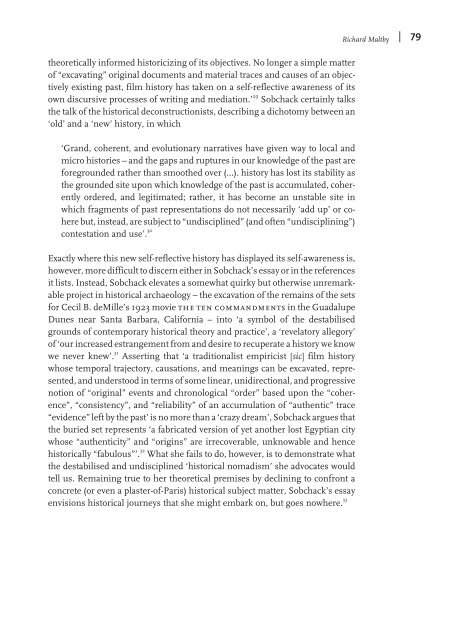Artikel: On the prospect of writing cinema history from below
Artikel: On the prospect of writing cinema history from below
Artikel: On the prospect of writing cinema history from below
You also want an ePaper? Increase the reach of your titles
YUMPU automatically turns print PDFs into web optimized ePapers that Google loves.
<strong>the</strong>oretically informed historicizing <strong>of</strong> its objectives. No longer a simple matter<strong>of</strong> “excavating” original documents and material traces and causes <strong>of</strong> an objectivelyexisting past, film <strong>history</strong> has taken on a self-reflective awareness <strong>of</strong> itsown discursive processes <strong>of</strong> <strong>writing</strong> and mediation.’ 29 Sobchack certainly talks<strong>the</strong> talk <strong>of</strong> <strong>the</strong> historical deconstructionists, describing a dichotomy between an‘old’ and a ‘new’ <strong>history</strong>, in which‘Grand, coherent, and evolutionary narratives have given way to local andmicro histories – and <strong>the</strong> gaps and ruptures in our knowledge <strong>of</strong> <strong>the</strong> past areforegrounded ra<strong>the</strong>r than smoo<strong>the</strong>d over (...). <strong>history</strong> has lost its stability as<strong>the</strong> grounded site upon which knowledge <strong>of</strong> <strong>the</strong> past is accumulated, coherentlyordered, and legitimated; ra<strong>the</strong>r, it has become an unstable site inwhich fragments <strong>of</strong> past representations do not necessarily ‘add up’ or coherebut, instead, are subject to “undisciplined” (and <strong>of</strong>ten “undisciplining”)contestation and use’. 30Exactly where this new self-reflective <strong>history</strong> has displayed its self-awareness is,however, more difficult to discern ei<strong>the</strong>r in Sobchack’s essay or in <strong>the</strong> referencesit lists. Instead, Sobchack elevates a somewhat quirky but o<strong>the</strong>rwise unremarkableproject in historical archaeology – <strong>the</strong> excavation <strong>of</strong> <strong>the</strong> remains <strong>of</strong> <strong>the</strong> setsfor Cecil B. deMille’s 1923 movie <strong>the</strong> ten commandments in <strong>the</strong> GuadalupeDunes near Santa Barbara, California – into ‘a symbol <strong>of</strong> <strong>the</strong> destabilisedgrounds <strong>of</strong> contemporary historical <strong>the</strong>ory and practice’, a ‘revelatory allegory’<strong>of</strong> ‘our increased estrangement <strong>from</strong> and desire to recuperate a <strong>history</strong> we knowwe never knew’. 31 Asserting that ‘a traditionalist empiricist [sic] film <strong>history</strong>whose temporal trajectory, causations, and meanings can be excavated, represented,and understood in terms <strong>of</strong> some linear, unidirectional, and progressivenotion <strong>of</strong> “original” events and chronological “order” based upon <strong>the</strong> “coherence”,“consistency”, and “reliability” <strong>of</strong> an accumulation <strong>of</strong> “au<strong>the</strong>ntic” trace“evidence” left by <strong>the</strong> past’ is no more than a ‘crazy dream’, Sobchack argues that<strong>the</strong> buried set represents ‘a fabricated version <strong>of</strong> yet ano<strong>the</strong>r lost Egyptian citywhose “au<strong>the</strong>nticity” and “origins” are irrecoverable, unknowable and hencehistorically “fabulous”’. 32 What she fails to do, however, is to demonstrate what<strong>the</strong> destabilised and undisciplined ‘historical nomadism’ she advocates wouldtell us. Remaining true to her <strong>the</strong>oretical premises by declining to confront aconcrete (or even a plaster-<strong>of</strong>-Paris) historical subject matter, Sobchack’s essayenvisions historical journeys that she might embark on, but goes nowhere. 33Richard Maltby | 79
















